
Headless CMS scales and improves WPWhiteBoard’s content distribution, flexibility, and personalization
Adeeb Malik
Do you feel constrained by a rigid, one-platform commerce solution that hinders innovation and takes away from the customer experience you want to deliver? You know you have to do something different.
Every new feature request is a mountain, your developers are beside themselves, and your marketing folks are impaired and can't implement the campaigns and construct the customized user experiences they've dreamed up. If this describes you, you're in the right place to learn about composable commerce migration
A composable commerce migration is a planned substitution of a monolithic platform with an elastic, best-of-breed commerce environment composed of independent commerce services federated together by APIs. This provides increased agility and scalability and the opportunity to build hyper-personalized user experiences.
The promise here is not novel technology but a novel approach: moving in a strategic, incremental manner rather than in one big, high-risk bound.
In its essence, composable commerce is an architectural strategy that liberates your business from monolithic, single-platform lockdowns through a composable commerce migration.
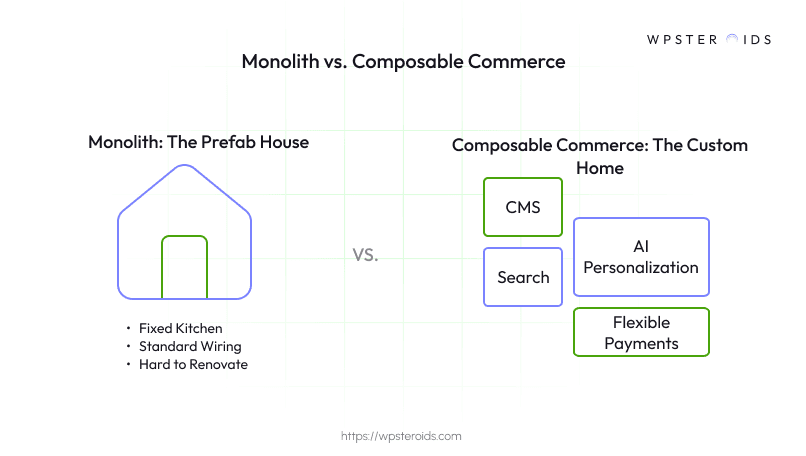
Rather than being tied to one system, you choose independent, best-of-breed software modules for every particular purpose, like search, payments, or content management.
These pieces are referred to as Packaged Business Capabilities (PBCs). They are subsequently stitched together with APIs (Application Programming Interfaces), which serve as a universal adapter, and all the disparate components can get along as a coherent system.
You are no longer purchasing a limiting product; you are building a versatile commerce stack that is perfectly suited to your company.
It's also worth contrasting this with headless commerce. Headless architecture splits the front-end customer experience (the "head") from the back-end functionality.
Composable commerce goes one step further by splitting all of the back-end pieces from one another, too, building a fully modular and interchangeable system from top to bottom.
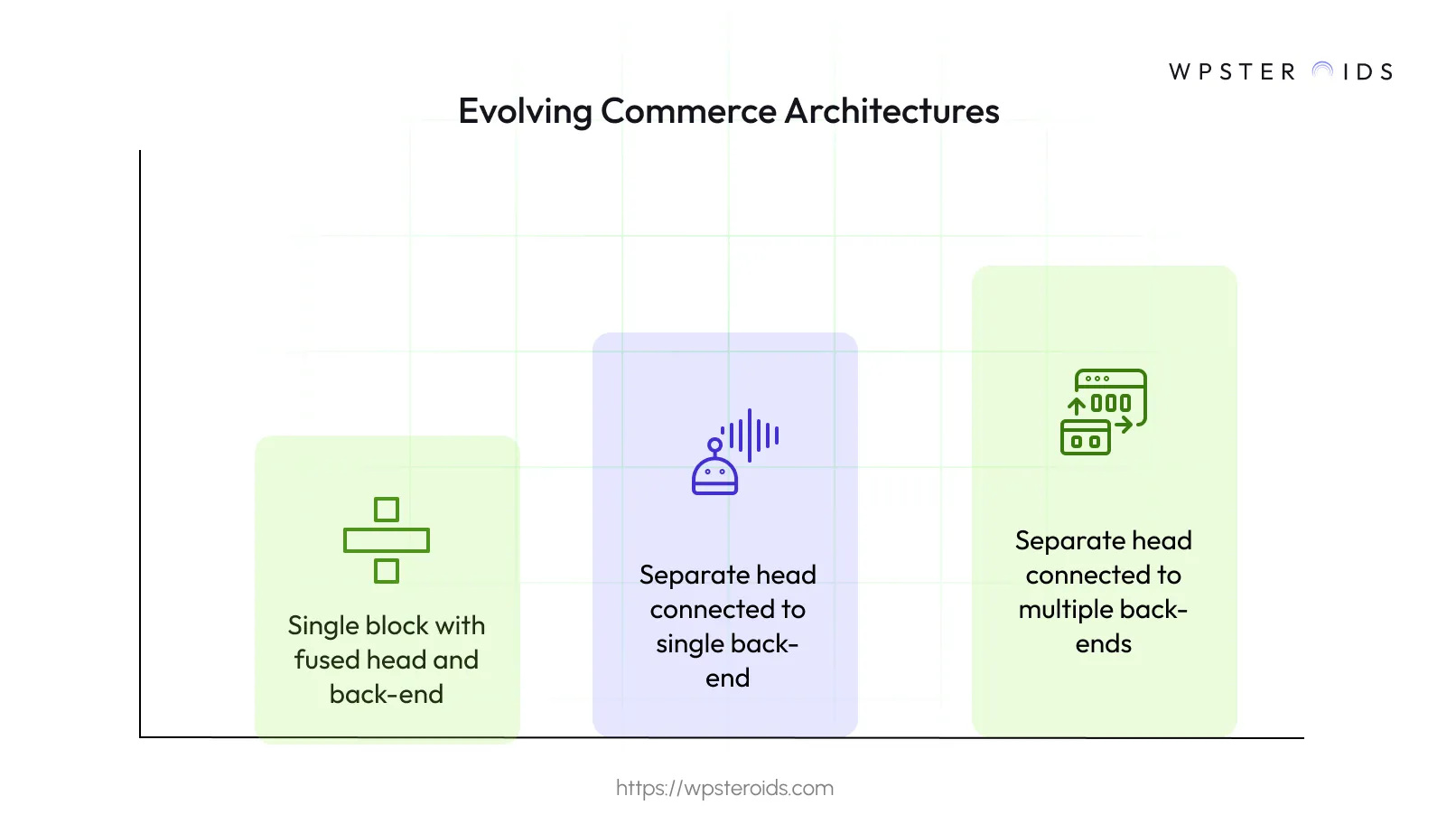
So, why does this matter to you as a leader?
Because this approach directly translates into a significant competitive edge.
Ultimately, moving to composable commerce is about shifting your organization from being a tenant on someone else's platform to being the architect of your own success.
It’s how you build a commerce solution that not only meets today’s demands but is ready to seize tomorrow’s opportunities.
Understanding what composable commerce is feels good, but it doesn't answer the urgent question you're wrestling with: "Why should I undertake this now?"
The push for a new initiative, especially one as significant as a composable commerce migration, has to be backed by a powerful strategic reason.
The reality is, the cost of inaction is growing daily, and the opportunity to leap ahead of your competition is right in front of you. This isn't just a technical upgrade; it's a fundamental response to a changing digital landscape.
Let's be honest. Your monolithic platform, once a reliable workhorse, is now likely the single biggest bottleneck to your growth. This is the core of the problem with legacy commerce.
Every time your business wants to launch a new feature, enter a new market, or create innovative user experiences for your commerce B2C customers, you hit a wall.
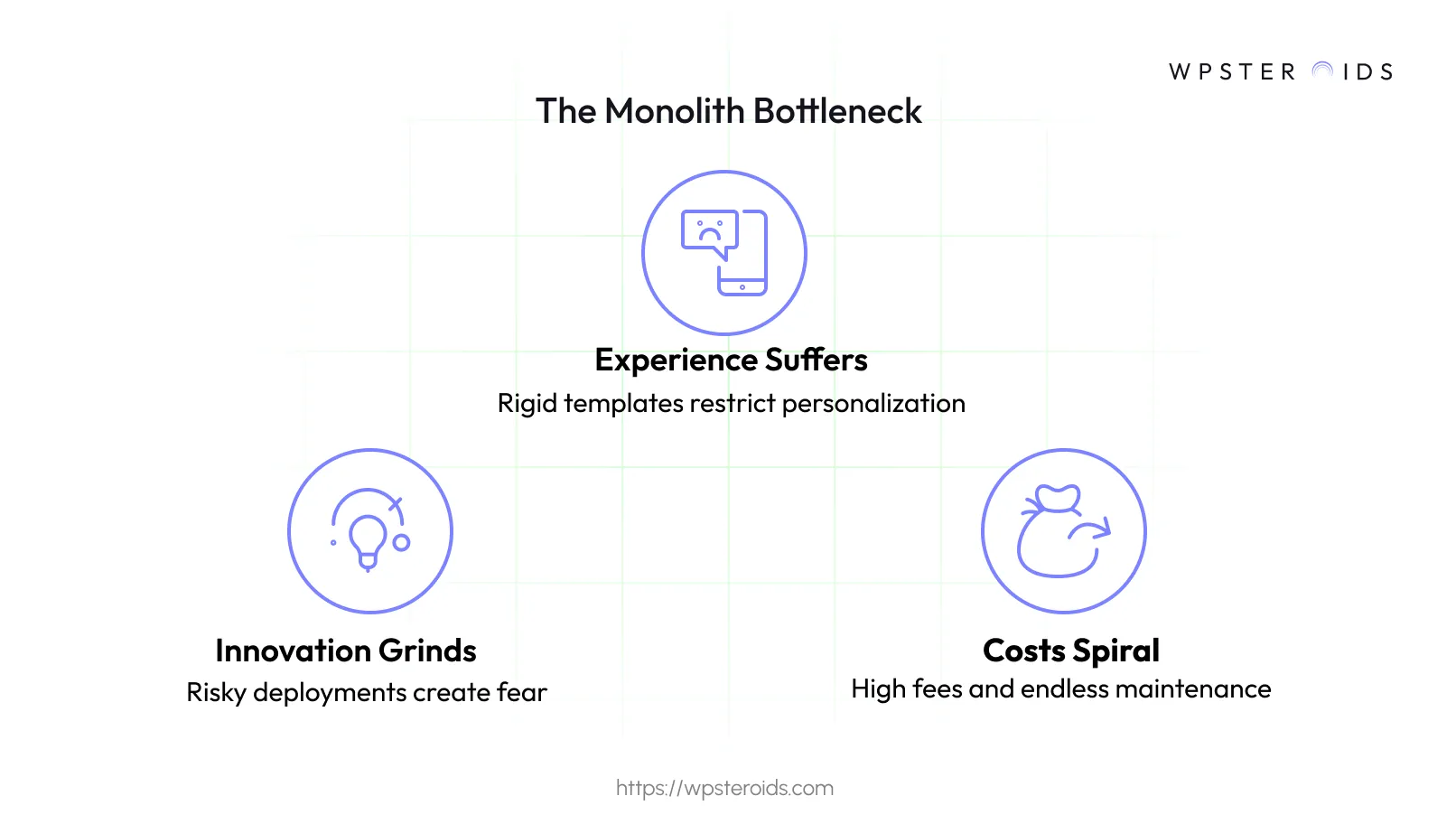
This isn't a sustainable position. You are trapped in a cycle of patches and workarounds while more agile competitors are sprinting ahead.
Here is the most important strategic shift you can make: Reframe your goal from "replacing the monolith" to "liberating the customer experience".
This is the key to de-risking your entire migration. The highest-impact, lowest-risk first move is often not to touch your core back-end systems at all. Instead, you can adopt a composable commerce approach by starting with the part of your business everyone sees: the front-end.
By decoupling the "head" (your website or mobile app) and implementing a modern front-end framework connected to your old back-end via an API, you gain an immediate, tangible victory.
Suddenly, your marketing and development teams are free. They can build faster, more engaging, and richer user experiences without waiting for the slow, monolithic back-end to catch up.
This approach builds incredible business momentum. You generate a visible ROI by improving conversion rates and customer satisfaction right away. This success creates the political capital and financial justification you need to then incrementally—and carefully—replace the back-end services piece by piece over time.
It transforms the project from a terrifying, high-stakes gamble into a series of strategic, value-driven wins.
If you're worried that this shift is too bleeding-edge, rest assured, the strategic momentum is undeniable. This is no longer a niche concept for tech-forward disruptors; it is rapidly becoming the mainstream standard for competitive businesses.
The most forward-thinking leaders are not asking if they should adopt a composable approach, but how and when. Industry analysts have confirmed this trend with hard data.
A recent Gartner report, for instance, delivered a stunning forecast that should catch the attention of every CTO and business leader. It predicts that by 2026, 60% of mainstream organizations will use packaged business capabilities (PBCs)—the core components of composable architecture—as a fundamental building block of their application suites.
Let that sink in. In the very near future, the majority of your peers and competitors will be operating with the agility and flexibility that a composable model provides.
The decision to move towards a composable architecture is a significant one. Before you dive into vendor selection or architectural diagrams, the most critical phase is the first one: strategic planning.
A successful migration is built on a foundation of honest self-assessment and clear-eyed planning. This is where you trade anxiety for control and build the internal case for change.
This preparation is the true starting point of your composable commerce migration journey.
Readiness for a composable commerce migration isn't just about having a budget. It's about organizational and cultural alignment. Ask yourself and your leadership team these critical questions to gauge if you're truly prepared to begin:
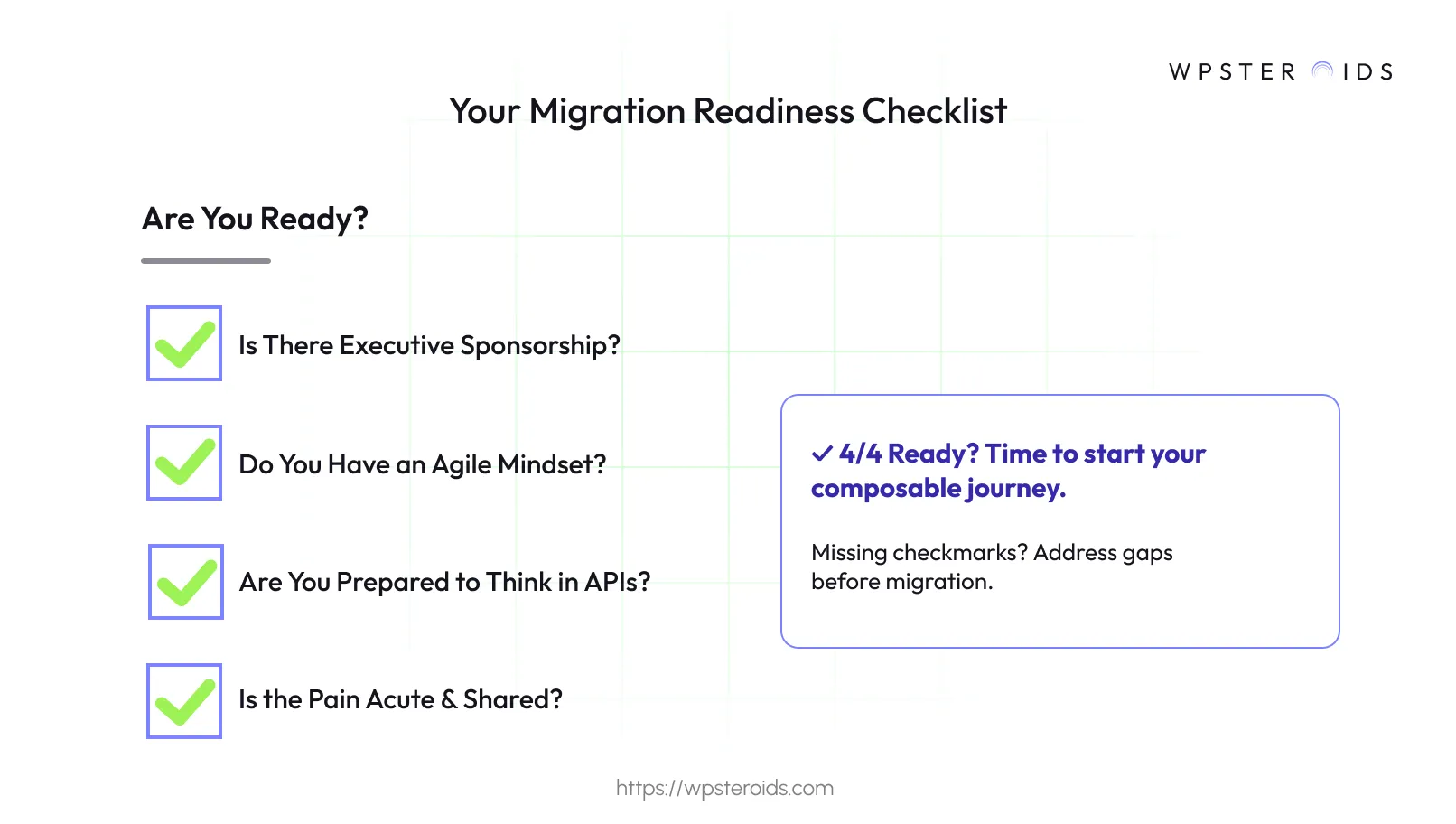
If you can't answer "yes" to these questions, your first task is to build that internal alignment. A successful migration starts with a unified team that understands both the challenges and the immense opportunities ahead.
With readiness confirmed, you can move on to a practical audit. You can't build your future state until you fully understand your current one.
The goal of a gap analysis for your composable commerce migration is to deconstruct your monolith—at least on paper—to see what essential functions it currently performs.
This analysis provides the blueprint for your phased migration, showing you exactly which pieces of the monolith you can begin to carve off and replace.
You cannot manage what you do not measure. A vague goal like "migrate to composable" is a recipe for scope creep and failure. Your objectives must be specific, measurable, and tied directly to your business needs.
Instead of a single, multi-year plan, define your composable commerce migration timeline as a series of phases, each with its own clear objective and timeline. Remember the strategy of liberating the customer experience first? That's a perfect Phase 1.
This phased approach transforms the migration timeline from a daunting, monolithic project plan into a dynamic roadmap that delivers tangible business value at every single stage.
It builds confidence, proves ROI, and makes the entire journey a manageable and even exciting process of continuous improvement.
Once you've done the essential prep work, you arrive at the most important strategic decision of your entire composable commerce migration journey: how you will make the transition.
In the past, replatforming was synonymous with the dreaded "big bang" approach—a high-stakes, all-or-nothing cutover that often ended in chaos. Today, there is a smarter, safer, and far more strategic playbook available.
In software terms, this means your composable migration involves building a new, composable system around the edges of your old monolith, gradually intercepting and replacing functionality piece by piece until the old system has no functions left to perform and can be safely retired.
To make this crystal clear, let's move away from software and think about a real-world project.
Think of your monolithic platform as an old, structurally sound but inefficient house you live in. A 'big bang' migration is like bulldozing the entire house and living in a hotel for a year while you rebuild—it's incredibly disruptive, expensive, and risky. What if the new foundation has a flaw? You're homeless.
A phased, incremental migration using the strangler-fig pattern is like building a brand-new, modern kitchen as an extension onto the old house. You connect it through a new doorway (the API).
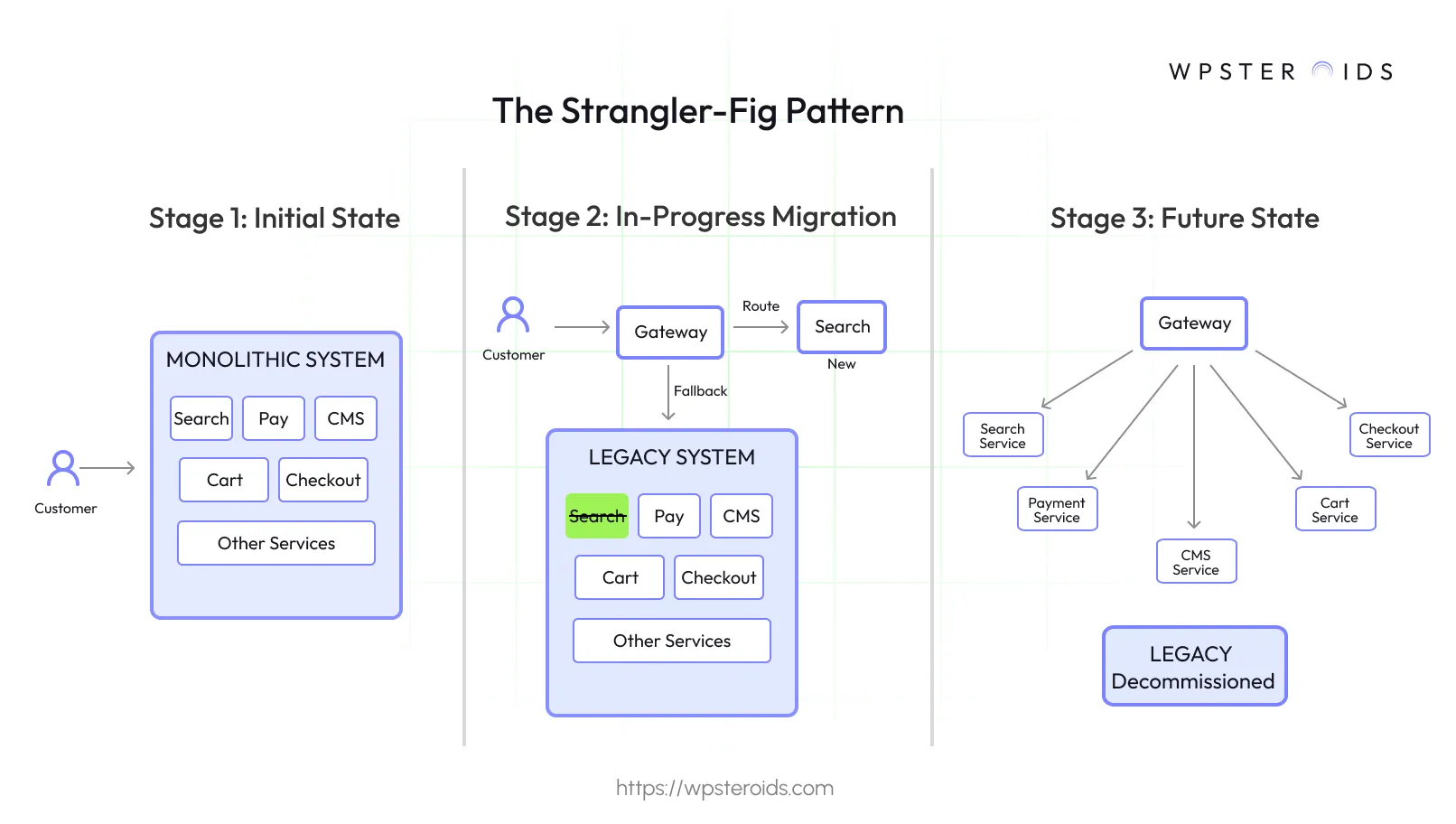
Once the new kitchen is fully functional and everyone loves it, you can lock the door to the old one and eventually demolish it. Then, you do the same for the living room, then the master bath—piece by piece, you replace the old house with a modern one, without ever having to move out.
This analogy is the key to your entire migration playbook. You are not bulldozing the business; you are renovating it, one high-value room at a time.
Choosing this incremental method over a big bang isn't just a technical preference; it's the single most important strategic decision you can make to guarantee business continuity and a successful outcome.
The goal is to avoid the scenario where you try to accomplish a big bang migration and risk everything on a single, flawless launch.
Here’s why a phased approach is superior:
The consensus among seasoned technology leaders is clear: The goal is not to switch systems overnight, but to ensure uninterrupted business operations while accelerating innovation.
A phased, incremental migration is the only responsible way to achieve both. It methodically transforms a terrifying leap into a manageable series of confident steps.
Following the incremental playbook, the composable commerce migration itself becomes a logical sequence of strategic phases.
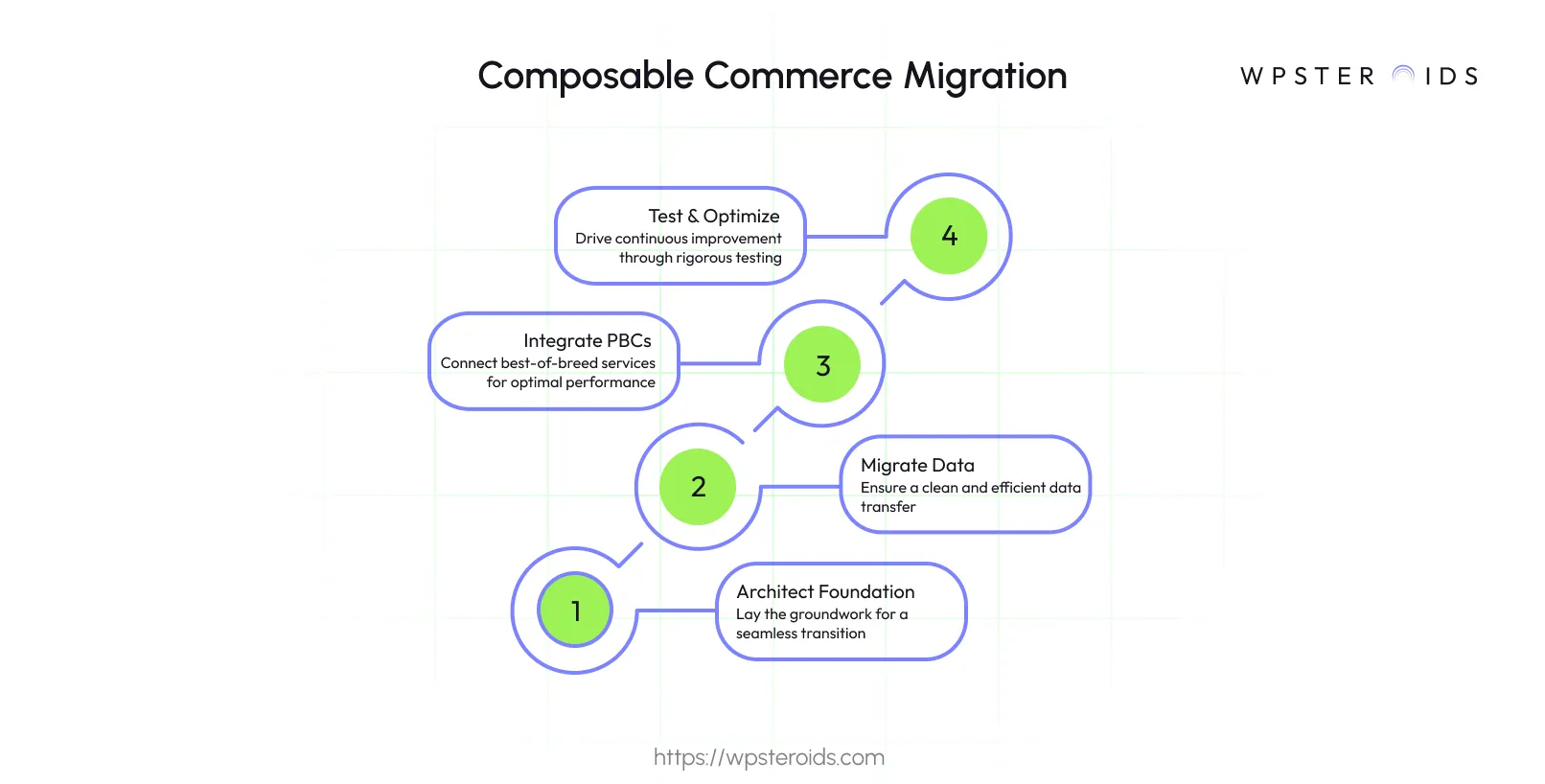
This isn't a rigid, one-size-fits-all checklist, but a proven process flow that you can adapt to your specific business needs. Each phase builds upon the last, delivering value and reducing risk along the way.
This is where you make your first, most impactful move: liberating the customer experience. The goal here is not to touch the monolith itself, but to build a new layer in front of it.
By the end of this phase, you have already achieved a massive win. Your customers see a faster, better website, and your front-end team is unshackled, all without the risk of altering your core transaction engine.
Data is the lifeblood of your business, and moving it is one of the most critical aspects of the migration. This phase often runs in parallel with others and requires meticulous planning.
Poorly executed data migration is where many composable commerce migration projects stumble.
Now the fun begins. With your API foundation and new front-end in place, you can start swapping out the old, clunky parts of your monolith with powerful, modern services. The order is determined by your strategic priorities identified during your gap analysis.
With each integration, you point another function away from the monolith and towards a superior, specialized service. The monolith gets "dumber" as your overall system gets smarter and more powerful.
This phase is not an afterthought; it is a continuous process.
Embarking on a composable commerce migration is a strategic move towards agility and growth, but it would be naive to think the path is without its bumps. Every composable commerce migration comes with inherent challenges and risks.
The difference between a successful migration and a stalled one lies in anticipating these hurdles and having a clear strategy to manage them. Let’s address the most common ones head-on so you can navigate them with confidence.
The beauty of composable commerce—its modularity—is also its primary challenge. Instead of managing one system, you are now orchestrating a dozen best-of-breed services.
This is where integration complexity becomes a real consideration. You are not just plugging in new services; you are managing the communication, data consistency, and performance between them.
Furthermore, you are not starting from a clean slate. Your monolithic platform carries years of "technical debt"—the implied cost of rework caused by choosing an easy (limited) solution now instead of using a better approach that would take longer.
This includes custom code, workarounds, and messy data old from past campaigns that were never cleaned up.
How to Manage It:
This is often the number one fear for any executive planning a composable migration: “Will this migration disrupt the business? Will we lose sales?" The goal is to perform this complex surgery on your business without the patient ever feeling a thing, or rather, only feeling positive improvements.
How to Manage It:
You've done it. You've incrementally strangled every last piece of functionality from your old monolith. The new composable ecosystem is humming along, handling all your business needs.
Now, it's time for the final, satisfying step: turning off the old machine for good. This must be done with care and precision.
How to Manage It:
A composable commerce migration is not just a technology project; it is a fundamental business investment. Like any major investment, its success must be measured not in lines of code, but in tangible business outcomes.
For you as a leader, building the business case and proving the return on investment (ROI) is just as important as executing the technical transition. The good news is that the impacts are significant, measurable, and start delivering value from the very first phase.
One of the most immediate and financially impactful benefits of a composable migration comes from performance. In e-commerce, speed equals revenue. A slow, clunky experience driven by a monolithic platform actively costs you money in lost conversions and poor search rankings.
By decoupling your front-end (the "head"), you gain complete control over the customer-facing experience. You are no longer held hostage by the performance limitations of your all-in-one system.
This allows your development team to use modern frameworks specifically designed for speed. The result is a dramatic improvement in key performance metrics:
Let's address the budget question directly. Yes, there is an initial investment in development, integration, and new software licenses. However, the financial story of composable commerce is one of shifting from a high-risk, high-cost capital expenditure model to a more flexible and predictable operational one.
Think of your monolith license: a huge, upfront cost, followed by expensive mandatory upgrades every few years just to stay supported. This is a classic CapEx (Capital Expenditure) model that is difficult to align with agile business goals.
Composable flips the script:
To prove the success of your migration and build momentum for future phases, you must track performance metrics with a comprehensive dashboard. This goes beyond just top-line revenue. A successful migration impacts the business across three key areas.
By tracking this balanced scorecard, you create a powerful, data-driven narrative that proves the ROI of your composable journey. You show not only that you've built a better customer experience, but that you've built a more agile and profitable business.
As we've explored, the journey to composable commerce is not the monolithic, high-risk project you may have once feared. It is a fundamental mindset shift. The most powerful takeaway is this: migrating to a composable architecture is not a single, disruptive event, but a strategic, incremental journey.
The feeling of being trapped by your current platform is a valid and frustrating reality for many leaders. But you are not powerless.
The core message of this guide is one of empowered relief: with the right strategy, you can confidently lead this transition. By focusing on an incremental, value-driven approach—liberating the customer experience first—you can lead a migration that minimizes risk and delivers immediate, tangible results.
Ready to begin your journey to a more flexible and powerful commerce future? Book your discovery call today to discuss your migration roadmap.
